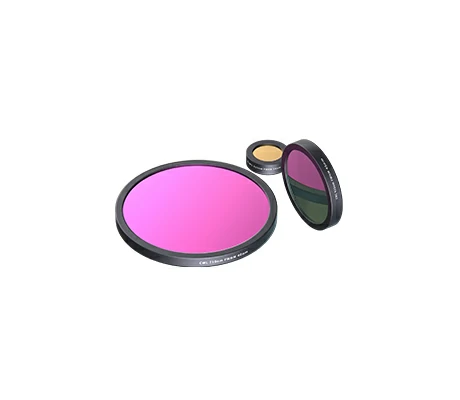
Advancing SNR in Detection Instruments
To enhance the performance of fluorescence detection instruments, there’s a growing focus on optimizing optical filters to boost signal-to-noise ratio (SNR). This drives two key trends in filter development: deeper cutoff depths and steeper transition edges—both critical for isolating fluorescence signals from excitation light.
1. Deeper Cutoff: Beyond OD6 for High-Power Systems
Deeper cutoff depth ensures better isolation between fluorescence and excitation light, directly improving SNR. For instruments using high-power lasers as excitation sources, the standard OD6 cutoff is no longer sufficient; demands are shifting to OD7, OD8, or higher.
Why it matters: Higher laser power increases stray light interference. A filter with OD8 cutoff blocks 99.999999% of excitation light, preventing it from swamping faint fluorescence signals—essential for applications like single-molecule imaging or high-throughput screening.
2. Steeper Edges: Maximizing Signal in Tight Spectral Windows
Steeper transition edges (faster shift from transmission to cutoff) allow wider passbands while maintaining effective isolation. This means more excitation energy reaches the sample, and more fluorescence signal is collected—key for systems using small Stokes shift fluorophores (where excitation and emission spectra overlap closely).
For example, a filter with a 1nm transition edge can retain 20% more fluorescence signal compared to a 3nm edge in small Stokes shift scenarios, significantly提升 SNR without compromising isolation.
Challenges in Manufacturing & Detection
Advancing cutoff depth and steepness raises both manufacturing and testing challenges:
- Manufacturing: Achieving OD7+ cutoff requires precise control of multi-layer dielectric stacks (50+ layers), with minimal defects to avoid light leakage. Steeper edges demand nanometer-level control over layer thickness.
- Detection: Current standards in China measure up to OD6-7 with 3-4nm resolution for steepness. Internationally, leading labs achieve OD9+ accuracy and<1nm resolution—critical for validating next-gen filters.
Bridging this gap requires parallel progress in filter design (e.g., advanced thin-film modeling) and testing technology (e.g., high-sensitivity spectrophotometers).
OPTOStokes: Ready for the Future of Fluorescence Filters
We’re engineering filters to meet these evolving demands, with:
- Quality Assurance: Testing capabilities aligned with international standards, ensuring every filter meets its specs.
Need a filter to boost your instrument’s SNR? Email sales@optofilters.com with your excitation wavelength, power level, and fluorophore type—our team will recommend a solution tailored to your needs. Or visit our site to explore our stock of high-performance fluorescence filters.


